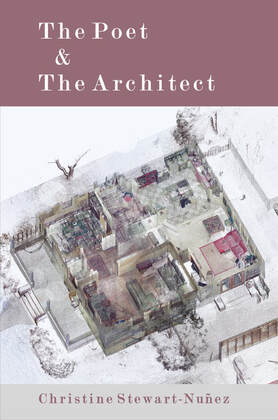Forms from a Marriage: On 'The Poet and The Architect'
Poet Christine Stewart-Nuñez is the author of numerous poetry collections and a professor at University of Manitoba. Her work explores women’s lives and art practices, as well as the body in relationship to public space. Madeline Beach Carey reviews The Poet and the Architect, published last year by Terrapin Books.
I read Christine Stewart-Nuñez’s 2021 book The Poet and the Architect just a few months after giving birth to my first child, so I experienced the poems in a haze of new motherhood, during which the harshness of the city and the built environment — the tiny elevators and crowded streets, the hostile architecture of the urban center — became suddenly, constantly apparent. In those early, heady days, the difference between public and private too felt suddenly vast and huge. I felt so vulnerable outside my apartment, so easily betrayed by buildings and sidewalks, so ill at ease with infrastructure.
In this collection Stewart-Nuñez explores building buildings and family life together in a way that feels simple, neat and clean, but is of course extraordinarily complex and oftentimes messy. She includes the domestic, and dare I say the feminine, as part of the built environment in a way that feels like pure alchemy.
These poems speak of marriage, of love at first sight, and then of love later on, after many years, after childbirth and the dull days of child rearing. At first glance the book seems to be a love letter to her husband, the architect in the title. But the poet is also exploring form, constantly, and radically, playing with structure on the page, and therefore echoing in the lyric the work of her partner. This book works as a love song to both her husband as an individual, but also to his profession — that of the architect. Perhaps only a poet of Stewart-Nuñez’s ambition could give us such a portrait, at once personal and universal.
The book is structured in four parts, or what the author calls “rings.” From the first ring I found most intriguing the poem “He Said, She Said,” which includes these lines:
He said algebra.
She said alchemy.
He said lines, quadrilaterals, parallelograms, dodecagons.
She said curve.
[…]
He said grid, list, distance.
She said bridal, fire, wild
From the get-go, we see these two mirror images, the Janus head of a marriage: the cool one, the passionate other. This framing — the two hemispheres of the brain, the masculine and the feminine — seems ordinary enough, but the author makes it consistently interesting, even surprising and new.
She also, rather bravely, argues for how much we need one another: the man and wife, the poet and the architect, the individual and the collective. In Ring Two, in “When You’re Away, I Consider Form,” following a quote from John Hedjuk (“I don’t make any separations. A poem is a poem. A building’s a building. . . . I mean, it’s all structure.”), the author speaks to that need in a moment of longing:
I need villanelles of you pulling
my breath like lines moving down
the page and the promise of rhyme
bending my ear. I need a sestina
of touch, patterns of palm, stroke,
skim, brush, and rub returning—
a cycle of sound and pressure I
apprehend in my bones.
In the third section, the poet’s vision expands to the lost, the dying, the rest of the world, while still tracing all the ghosts in a marriage. In “Love and Fear in a Pandemic,” she writes:
Once, when pregnant with death, heart stopped
within my womb, I realized I loved
someone I’d never meet. I draw on that
vibration as April deepens in this
rural place, folks still lifting their laughter
to the sky in large, loquacious groups.
Last night, my husband said if he takes sick
and succumbs, he’ll die thinking of me, and I
realized the power of loving through time.
Elsewhere, bodies pile up, hospitals overwhelmed, and survivors grieve.
“Elemental Lesson,” a poem we come across late in the collection, represents perhaps the basic pillars of the project: how architecture and language interact and intertwine to form a steady, daily kind of love within, and around, the necessities of human life:
When my husband said brutalist,
I thought oppressive and impenetrable
because I lacked imagination.
In Montréal, we biked by Habitat 67
and the one-hundred forty-six
block-stacked apartments emerged
from the shadowless landscape—sky
and cubes gray upon gray, all
concrete and corner with rectangle
windows wrapping the tops. He pointed
out stairs, access points, garden spots.
When he said brutalist and concrete,
I thought severe and unevolved because
mixing limestone, gravel, sand, and cement
meant rough and simple, like sidewalks.
While reading this book I thought of it as an ode to the disciplines each member of the couple has chosen, a deep dive into their vocations and what our professional pursuits mean to our private lives and to our families. Throughout the book we find echoes of the Italian writer Natalia Ginzburg’s famous advice about vocation and children from her essay, “The Little Virtues.” “This is perhaps the one real chance we have of giving them some kind of help in their search for a vocation — to have a vocation ourselves, to know it, to love it and serve it passionately; because love of life begets a love of life.” In this excavation of each spouse’s vocation, Stewart-Nuñez achieves a remarkably complex collection: finding beauty and deep significance in what we might at first glance, mistakenly label the everyday or quotidian.

The Poet & The Architect
Christine Stewart-Nuñez
85 Pages
Paperback
ISBN 9781947896451
Terrapin Books
Purchase this book
